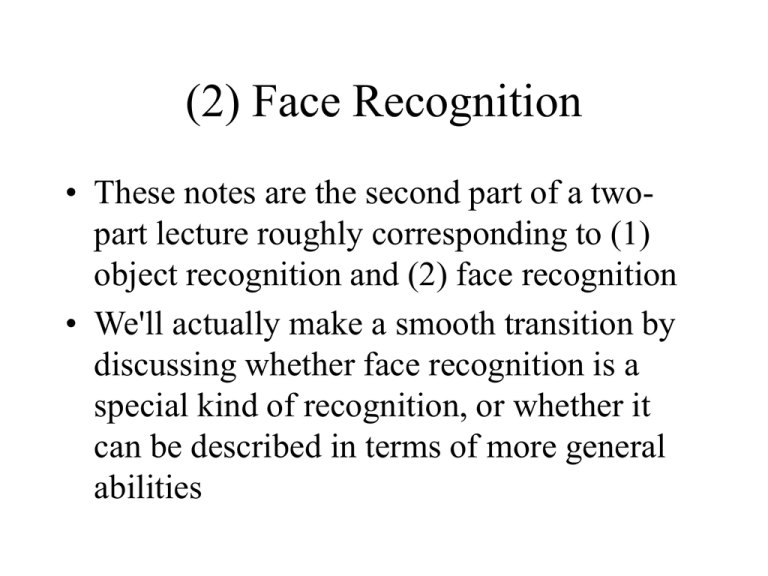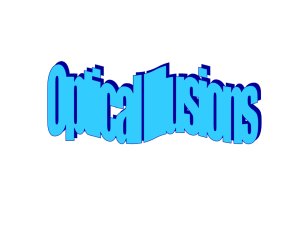ppt faces
advertisement

(2) Face Recognition • These notes are the second part of a twopart lecture roughly corresponding to (1) object recognition and (2) face recognition • We'll actually make a smooth transition by discussing whether face recognition is a special kind of recognition, or whether it can be described in terms of more general abilities 6. Agnosias: Impairments of recognition • Agnosia: from Greek, literally, "ignorance"; the inability to recognize basic objects, usually due to brain damage Object agnosia • Patients cannot recognize common objects, but have no trouble with recognizing faces • Note that visual acuity in object agnosia is unharmed • When object agnosics are shown art with "hidden faces" in an array of objects, they quickly report only being able to see the faces… [See Oliver Sack's The Man Who Mistook His Wife for A Hat for more case-study details] Can you find all 13 faces? Prosopagnosia ("face blindness") • Patients cannot recognize people's faces, although basic recognition appears spared • Again, visual acuity is spared • Prosopagnosics often learn to identify people on the basis of their hair, dress, voice, and other peripheral cues Bill's Face Blindness Page (on-line: http://www.choisser.com/faceblind/) • A prosopagnosic shares some anecdotes from his life regarding his inability to recognize faces as well as most; the early age of some of the anecdotes suggests that he may have been born with it • He remembers (age 6) seeing a bank robber movie and saying that it was silly for bank robbers to only cover their faces, since you could still see the rest of them (betraying his reliance on peripheral cues that most of us ignore) • Also left the Navy after 4 days-- when everyone got the same haircut and uniform, he couldn't recognize anyone anymore! Double-dissociation? • It appears that some patients show a deficit for recognizing objects, while others show a selective deficit for recognizing faces • This suggests that objects and faces may be processed by separate perceptual mechanisms/brain areas 7. Recognition in the healthy brain • View-selective responses in monkey inferotemporal cortex (IT): When monkeys are trained in a recognition task like that of Bulthoff & Edelman (see “Seeing Objects” lecture), you can find neurons that respond maximally to one of the trained views of the object, and responses fall off as the object is rotated away from this preferred view Columnar organization in monkey IT • Different columns of cortex (see “Visual Pathways” lecture for summary of how such columns work) have neurons that are responsive to different types of basic shapes, forms, and even faces Columnar organization in IT Face-selective neurons in inferotemporal cortex • This was a rather controversial result when first published • Are neurons really responsive to faces per se, or just to a complex set of features that faces happen to have? (And is there a difference between these 2 criteria?) • Anyway, neurons in IT give big responses to faces Face cells? Various manipulations make the argument more convincing: • Full (monkey) face: large response • Blank out eyes or mouth: weaker response • Scramble features randomly: very small response • Change angle of face gradually: gradual fall-off of responses with increasing head-turn • Human face: large response Using functional Magnetic Resonance Imaging (fMRI) • Subject view faces for a while, then pictures of objects • One area becomes more active during faceviewing; another area becomes more active during object-viewing Faces vs. Objects (human fMRI) 8. Face recognition is special • There are several pieces of evidence that suggest that face recognition might be special: – Infants show a tendency to track moving faces, at just 30 minutes old – Face agnosia without object agnosia; object agnosia without face agnosia – Human fMRI result of objects vs. faces – Inversion effect: Normal subjects are better at recognizing upright rather than inverted faces – Inverted inversion effect: Prosopagnosics are better at recognizing inverted rather than upright faces (!!! Why do you think this happens?) 9. Face recognition isn't special • However, there are also several pieces of evidence that suggest that the processing of faces is not special: – In monkey IT, face columns are intermingled with other columns (objects/shapes) – Actually, prosopagnosics often show impaired recognition ability for non-face objects within a category (e.g., birds, cars, etc) – After training people to recognize non-face objects, subjects show face-recognition-like performance (e.g., inversion effect)… Greebles • After this special training, brain activity shifts from object area to face area • Specifically, this experiment required subjects to learn to identify "greebles”, which are weird little shapes that are complex (like faces), but don't look much like them… Meet the Greebles Outcome of Greeble study: • Subjects learned to discriminate between various types of Greebles, and, as they became experts, their brain activity shifted to the putative 'face' area








